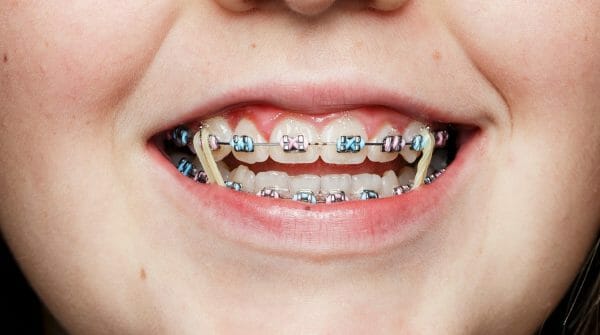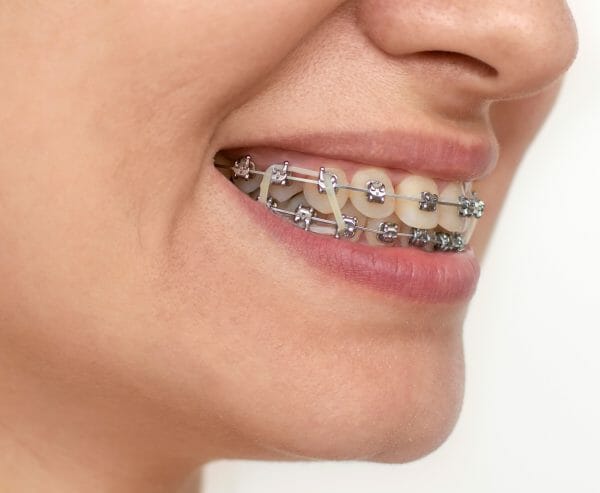There are two different kinds of elastics that orthodontists employ to help straighten teeth and correct bite issues in children, teens, and adults. The first type is called ligatures, or o ties for braces. Ligatures are small, elastic rings that secure the archwire to brackets in traditional (sometimes called “twin”) bracket systems. In self-ligating bracket systems, o ties are not required, but can be used as a fun color decoration. O ties get replaced at every adjustment appointment.
The other type of elastic band is orthodontic rubber bands, or elastics. These are a powerful tool used to correct bite issues. They connect from top teeth brackets to bottom teeth brackets and shift the bite into proper alignment.

How Do Orthodontic Elastics Work?
Orthodontic elastics work by attaching to small hooks on the brackets in specific configurations and at specific angles to produce the proper force to correct the bite. In addition, they can also be used to pull a specific tooth or segment of teeth into position.
Elastics help to align the bottom and top rows of teeth over time, helping teeth to fit together properly, which gives the patient a better-looking and more comfortable bite. Elastic bands for braces are crucial in achieving an ideal result.
What Do Elastics Correct?
Elastics correct several different types of bad bites, also known as malocclusions.
These include:

Types of Elastics
The types of elastics used in orthodontic treatment are varied and can be categorized by force, material and size. Three common strengths of elastics are:
- Light
- Medium
- Heavy
The force applied is measured in ounces (oz) or grams (g). The exact amount of force applied may vary by manufacturer.
The available sizes of elastics vary as well, and they are calculated by the measurement of its diameter. Because they are small, this is usually in fractions of an inch. The size of the band chosen is based on how far it would need to stretch to achieve the desired outcome.
The different materials used for elastics are latex and synthetic (non-latex). Latex bands are commonly used due to their high rate of flexibility; however, latex-free bands can be easily substituted for those with a latex allergy.
Additional Classifications
Both latex elastic bands and latex-free (synthetic) bands can be classified based on the type of correction.
Some of these types include:
- Class I – Used to help close spaces between teeth when the front-to-back relationship of the upper and lower teeth is generally well coordinated. These are oriented in a horizontal direction.
- Class II – Used to correct “overbite” (termed overjet by dentists) – when the upper teeth set forward of the lower teeth. These are oriented in a diagonal direction.
- Class III – Used to correct underbites – when the lower teeth set forward of the upper teeth. These are oriented in a diagonal direction.
- Vertical – Used to correct open bites – when a vertical space exists between the biting surfaces of the upper and lower teeth in either the front or back of the mouth. These are oriented in a vertical direction.
- Cross – Used to correct crossbites – when the side-to-side relationship of the back teeth is not in line. These elastic configurations are oriented in a diagonal direction and cross over the biting surfaces of the teeth.

How to Put Elastic Rubber Bands on Braces
The amount of wear time and configuration of elastics prescribed is specific to each unique patient. When prescribed, changing the bands frequently is necessary because the rubber bands lose their elasticity over time. Wearing the same elastics for too long or reusing previously worn elastics may slow tooth movement and prolong treatment.
Every time rubber bands are removed for eating or brushing, a new set should be put in. This means 4 to 5 sets of rubber bands per day should be used. Constant and even force application is critical for the best orthodontic outcome.
A written diagram will be given to the patient detailing how and where to hook up the elastics, per the orthodontist’s instruction. If manual dexterity is good, using fingers (with clean hands) is the easiest and most efficient way to place elastics in the mouth.
Plastic hooks can help aid in the placement of elastic bands for those who have trouble using their fingers directly. Simply place the band on the end of the plastic hook and use it to guide the band around the hook of the bracket and pull it toward and over the hook of the opposite bracket.
Additional Tips for Rubber Bands
- Keep teeth close together during placement so the elastic doesn’t need to stretch too far to be hooked up.
- Have at least two bags of elastics, one for home and another for on-the-go to ensure enough elastics are on hand. This is an important tip for busy teenagers.
- Never use traditional rubber bands as replacements, even temporarily. Your orthodontist is happy to supply more elastics if you lose them or run out. Contact Burke & Redford Orthodontists for replacement orthodontic elastics as needed.

Types of Braces That Do and Don’t Use O Ties
The type of braces that must use elastic o ties are traditional “twin” type metal braces and ceramic braces. Metal and ceramic twin system braces employ these colored or clear elastic bands in the form of ligatures to hold the archwire in place.
Ceramic braces differ from metal braces in their appearance as well as in their composition. The brackets of ceramic braces are composed of ceramic, as the name implies, and can be tooth colored or clear. Paired with a white-coated wire, this greatly reduces the appearance of braces compared to traditional metal. Before and after ceramic braces pictures show the great results that can be achieved with these systems.
Metal braces are an industry standard for a quality orthodontic outcome and have been for decades. Technological advancements have produced smaller and smoother bracket designs, bringing higher comfort levels compared to the metal braces of the past.
Self-ligating braces, such as GAC Innovation, GC Experience, and Damon clear braces, do not require the use of o tie elastics. The “open-and-close” door system holds the archwire in place, negating the need for o tie elastic ligatures. However, o ties can be used with self-ligating systems if the patient wants to decorate their braces with a specific color pattern.
Dr. Ryan Redford is one of the most referred orthodontists in the Inland Empire. Schedule a Free Consultation to discuss braces or Invisalign Teen options for your child today.